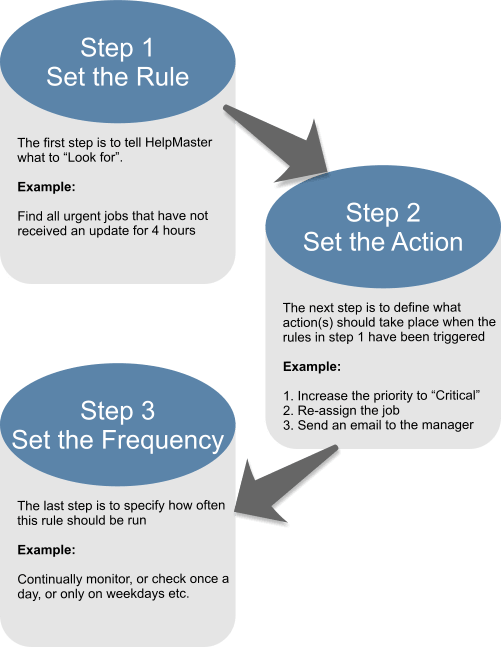Priority Manager Overview

The Priority Manager is an powerful automation feature of HelpMaster that can be used for escalation and service level agreement (SLA) management. Additionally, it can be used to automatically modify existing jobs, send email to both staff and clients, and perform other actions relevant to your service environment.
By using the Priority Manager, the business can build up a rich set of escalation and service level agreement profiles that will help your team achieve goals and provide useful managerial reporting.
How does it work?
At the heart of the Priority Manager are profiles. Think of these profiles as the business rules that are defined by your business. These profiles are run at regular intervals against your HelpMaster database and can perform a wide variety of functions with your HelpMaster data. Every profile contains the following 3 elements as depicted below.

While the desktop edition of HelpMaster is used to build up your Priority Manager profiles, a separate Windows Service program is responsible for regularly executing the Priority Manager profiles. Typically, the Priority Manager Service is installed on a centralized, server style computer that has access to your HelpMaster database. It will run at regularly defined intervals on that machine and will apply your profiles - your service level agreements to your HelpMaster database. For further information about this, refer to the Priority Manager Service.
What are some examples of what the Priority Manager can do?
The Priority Manger is a very powerful tool capable of applying many different service level agreement scenarios. It can be used as a sales management tool, a contact marketing campaign manager, an ITIL compliancy utility, a simple messaging system, or a complex, SQL driven workplace business rules enforcer.
At a basic level, it can:
- Escalate job priority based upon the time a job has been opened for
- Re-assign jobs
- Automatically close jobs
- Send email to clients, staff and others
More advanced features include:
- Completing template actions against an existing job
- Adding Actions to do, or tasks to an existing action
- Fully SQL scriptable actions
See Also
Feedback
Was this page helpful?
Glad to hear it! Please tell us how we can improve.
Sorry to hear that. Please tell us how we can improve.